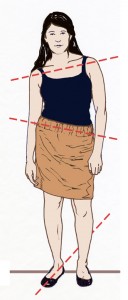 There is no true symmetry across the two sides of the human body. No one is fully ambidextrous. Our skeletal structure is the same on both sides of the body with the corresponding bones all being the same size and shape.
There is no true symmetry across the two sides of the human body. No one is fully ambidextrous. Our skeletal structure is the same on both sides of the body with the corresponding bones all being the same size and shape.
One in a million people might have one leg shorter than the other due to one of the bones being shorter on one side but it is very rare. The reason for our imbalance is that we have a very different musculature on both sides of the body which leads us to having a dominant side. In the same way that everyone is handed, right or left, everyone to one degree or another has one leg shorter than the other.
A few years ago when I went to the Bodies exhibit here in NYC’s South Street Seaport, the aspect of the show that struck me most was viewing the same muscle on both sides of the body. Very often you would have a strong solid muscle on the right side that looks like it was straight out of an anatomy book and then on the other side there would be this limp and flaccid excuse for a muscle that barely existed.
One leg is shorter than the other most often because of the tightness of the psoas major. Everyone’s side to side imbalance varies for different reasons but my take is that leg length discrepancy is mainly due to the psoas muscle and its imbalance. The psoas connects at the base of the rib cage, all along the lumbar spine and then down and back to the back half of the femur, or leg, bone.
When the psoas is tight it pulls the affected leg up into the hip socket and often pulls the hip up towards the rib cage and the rib cage down towards the hip. That is just one of the ways a tight psoas can manifest. But the shortening or pulling up of the leg into the hip socket is usually the first response to any tightening in the psoas muscles.
